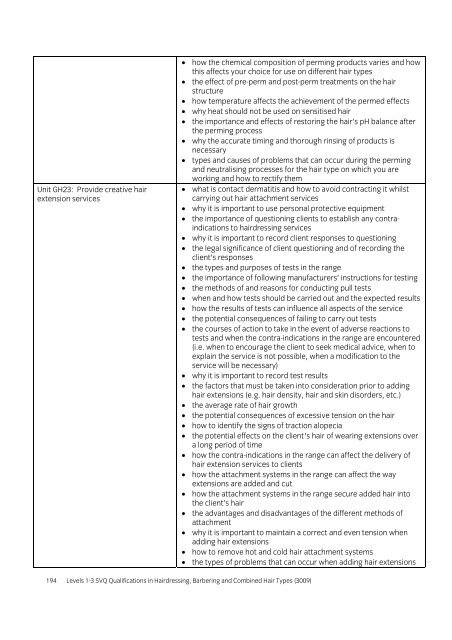3009 SVQ Assessment handbook v2 - City & Guilds
3009 SVQ Assessment handbook v2 - City & Guilds
3009 SVQ Assessment handbook v2 - City & Guilds
You also want an ePaper? Increase the reach of your titles
YUMPU automatically turns print PDFs into web optimized ePapers that Google loves.
Unit GH23: Provide creative hair<br />
extension services<br />
• how the chemical composition of perming products varies and how<br />
this affects your choice for use on different hair types<br />
• the effect of pre-perm and post-perm treatments on the hair<br />
structure<br />
• how temperature affects the achievement of the permed effects<br />
• why heat should not be used on sensitised hair<br />
• the importance and effects of restoring the hair’s pH balance after<br />
the perming process<br />
• why the accurate timing and thorough rinsing of products is<br />
necessary<br />
• types and causes of problems that can occur during the perming<br />
and neutralising processes for the hair type on which you are<br />
working and how to rectify them<br />
• what is contact dermatitis and how to avoid contracting it whilst<br />
carrying out hair attachment services<br />
• why it is important to use personal protective equipment<br />
• the importance of questioning clients to establish any contraindications<br />
to hairdressing services<br />
• why it is important to record client responses to questioning<br />
• the legal significance of client questioning and of recording the<br />
client’s responses<br />
• the types and purposes of tests in the range<br />
• the importance of following manufacturers’ instructions for testing<br />
• the methods of and reasons for conducting pull tests<br />
• when and how tests should be carried out and the expected results<br />
• how the results of tests can influence all aspects of the service<br />
• the potential consequences of failing to carry out tests<br />
• the courses of action to take in the event of adverse reactions to<br />
tests and when the contra-indications in the range are encountered<br />
(i.e. when to encourage the client to seek medical advice, when to<br />
explain the service is not possible, when a modification to the<br />
service will be necessary)<br />
• why it is important to record test results<br />
• the factors that must be taken into consideration prior to adding<br />
hair extensions (e.g. hair density, hair and skin disorders, etc.)<br />
• the average rate of hair growth<br />
• the potential consequences of excessive tension on the hair<br />
• how to identify the signs of traction alopecia<br />
• the potential effects on the client's hair of wearing extensions over<br />
a long period of time<br />
• how the contra-indications in the range can affect the delivery of<br />
hair extension services to clients<br />
• how the attachment systems in the range can affect the way<br />
extensions are added and cut<br />
• how the attachment systems in the range secure added hair into<br />
the client’s hair<br />
• the advantages and disadvantages of the different methods of<br />
attachment<br />
• why it is important to maintain a correct and even tension when<br />
adding hair extensions<br />
• how to remove hot and cold hair attachment systems<br />
• the types of problems that can occur when adding hair extensions<br />
194 Levels 1-3 <strong>SVQ</strong> Qualifications in Hairdressing, Barbering and Combined Hair Types (<strong>3009</strong>)
















